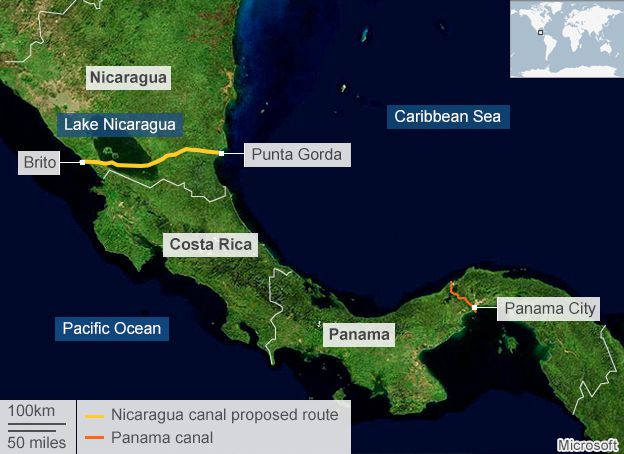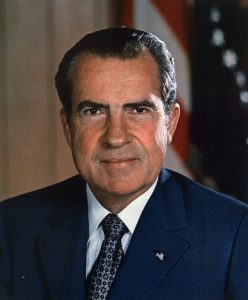Back in the early 1900s, the United States seriously considered using the Central American country of Nicaragua for the construction of a canal—a groundbreaking development, connecting the Atlantic and the Pacific oceans. After several studies done in the country, and realizing that Nicaragua was not economically prepared for a project of that magnitude, they decided that Panama was to be the location for the American built canal. A century later, it appears that the creation of the Nicaragua grand canal could happen. Nicaragua is currently one of the poorest countries in the Western Hemisphere, as it has been heavily affected by dictatorships, civil war, and natural disasters. After the governmental revolution of the 1980s, Nicaragua became a society undergoing progress.1 The country’s unconstitutional president, Daniel Ortega Saavedra, is now hoping to launch one of the world’s most ambitious infrastructure schemes—a canal project to rival the Panama Canal.2 His proposal promises to release Nicaragua from the terrible effects of poverty. Although the project sounds promising, its uncertainty has caused incredible amounts of controversy and chaos throughout the country. Without a doubt, the creation of the Interoceanic canal through Nicaragua would deeply aggravate the nation’s environment, economy, and sovereignty.

Before examining the complexity of this billion-dollar project, it is important to understand Nicaragua’s historical context. Nicaragua is the largest republic of Central America, having a land area about equal to that of the state of New York.3 This Central American country is not only known for its ecological wonders, but also for the countless tragedies it has been through. In the 1960s, Nicaragua was the leading economic power of central America. Nevertheless, after a terrible 6.2 magnitude earthquake in 1972, and a bloody civil war, Nicaragua never truly recovered economically. Currently, the Sandinista Regime, headed by Daniel Ortega, governs the country. For the past eight years, the administration has sought distinct investment opportunities for the Nicaraguan economy to flourish. The creation of a multi-million dollar water park, a new airport, and a colossal interoceanic canal, are some of the proposals leading Ortega’s governmental plans. In early 2013, Ortega made headlines across the world by announcing that a Chinese rookie firm (HKND) would build a $40 billion interoceanic canal in Nicaragua that would compete with the Panama Canal and turn Nicaragua from a poverty-stricken nation into a global shipping power overnight.4 If built, the Grand Interoceanic Canal would be more than twice the length of the Panama Canal. But it would be the perfect size for the next generation mega-container ships.

What is the HKND? More importantly, who is the so-called main investor? In 2014, Ortega pushed a law through the Nicaraguan government, with almost no debate, that gave total control of the construction of the interoceanic canal to a mysterious Chinese company — The Hong Kong Nicaragua Canal Development Investment Co.5 The HKND is headed by Wang Jing, a Chinese telecommunications magnate. The decree gave Wang’s company an exclusive concession to build an interoceanic canal and seven related projects, including ports, airports, and tourism resorts.6 The almost frightening fact, however, is that neither the HKND nor Jing have had any prior experience dealing with a project of this magnitude. The enigmatic HKND group doesn’t appear to have any direct ties to the Chinese government, nor any international experience managing infrastructure projects.7 Amazingly, there is not much more information concerning the HKND. The only information available comes from the limited governmental publications Ortega’s administration has released. However, one thing is certain: Jing’s fortune arose from his experience in telecommunications, not construction.8

Nicaragua is a country decorated with extensive beautiful sceneries. To name a few—majestic volcanoes, breathtaking lakes, and emerald coast beaches. The country has never truly developed, leaving its natural resources in a virgin condition.9 That is the reason behind Nicaragua’s booming eco-tourism economy. The HKND’s ambiguity is not the only concern. If completed, the construction of the canal would sever 170 miles across the nation’s fragile ecosystems, virgin forests, and scenes of incredible beauty.10 The New York Times remarked the atypical nature of the project, calling it “the largest movement of earth in the planet’s history.” Environmentalists have made it very clear that the project could have disastrous consequences for the country’s water supply, including the massive Lake Nicaragua, considered a key source of drinking water for Central America for decades to come.11 In the same manner, its construction would carve through miles of protected areas that are home to endangered species, including the jaguar, and legally recognized indigenous lands.12 The Cocibolca Organization, which has strongly opposed the project, has already carried out a study on the projected environmental impact of the project, and the results were extremely unfavorable. Cocibolca Group spokeswoman, Mónica López Baltodano, stated: “the canal’s route will impact seven protected areas, which will make the Mesoamerican biological corridor unviable, which will have enormous consequences on biodiversity.”13

Nicaragua is recognized as one of the poorest countries in the Western Hemisphere. It has a low gross domestic product (GDP) per capita of $460 per year. Currently, tourism ranks as the third largest source of foreign capital.14 That means that the country prospers partly because of its tourism business, primarily owned by local holders. Although the government has emphasized the positive economic impact of this project, there are various aspects of it that depict the contrary. José Adan Aguerri, president of Nicaragua’s largest business chamber, warns that private-property owners will be “defenseless” against expropriations by the canal project. Until the canal’s route is established, everyone owning property in the indeterminately large canal zone that’s been penciled across the middle of the country is at risk of being expropriated—a legal uncertainty that may bring an instant chill to Nicaragua’s investment climate.15 Ortega has also promised more than 50,000 jobs to the Nicaraguan people, arising from the construction of the canal. Nevertheless, the Chinese company has the authority to “design, develop, engineer, finance, construct, possess, operate, maintain, and administer” the canal, which means that the vast majority of the jobs will not necessarily go to Nicaraguans, but rather to HKND employees.16
As mentioned previously, a Nicaraguan bill passed in the country’s parliament gave the HKND total control of the project. The law is a 100-year tax-free concession that includes the right to expropriate lands at will. This means that HKND officials have the legal right to take away homes, farms, and businesses along the canal route. This fact particularly has caused outrage among Nicaraguans. “We’re Campesinos. We don’t have anything to do with any canal. We’re farmers. The people in the capital eat from the work of our hands,” said Rafael Bermudez, a farmer who might be forced off of his land.17 Early 2015 was filled with citizen protests, where Nicaraguans marched in the capital’s streets to challenge the construction. Civil-society groups also worry that the HKND, along with Ortega’s intent to create a privatized enclave in the middle of Nicaragua, will govern for the next 50 to 100 years under a self-styled Canal Commission, regardless of the actual government in power in Managua. “Nicaragua is not for sale. Nicaragua belongs to all Nicaraguans and is not the private property of Ortega and his family,” reads a declaration signed by twenty-one civil-society organizations.15

It has been almost four years since the Nicaraguan government made the Canal Plans public. Surprisingly, neither Ortega nor government officials have mentioned the project’s process over the past two years. There are various conspiracies concerning what could have happened. It has been said Wang Jing, the Chinese telecom tycoon behind the project, lost about 85% of his fortune in a stock market crash, and has not visited Nicaragua for a year, fueling suspicion that the project may be dead.19 Now it appears that the $40 billion project is on hold amid rumors that it has been shelved because of the popular protests and China’s improved relations with Panama. Although the future of this project seems to be nothing but uncertain, it is obvious that if it’s ever completed, it will not bring progress to Nicaragua. Rather, Nicaragua would only play host to a Chinese venture.
- Richard L. Harris, “The Revolutionary Transformation of Nicaragua,” Latin American Perspectives, no. 1 (1987): 4. ↵
- BBC Monitoring, “Nicaragua country profile,” BBC News, last modified July 5, 2017. ↵
- W. L. Saunders, “Nicaragua,” The Annals of the American Academy of Political and Social Science, no. 1 (1916): 186. ↵
- “Four years later, Nicaragua’s $40 billion interoceanic canal remains a pipe dream,” The Miami Herald, July 5, 2017. ↵
- “Nicaragua canal: In a Sleepy Pacific Port, Something Stirs,” The Guardian, November 24, 2016. ↵
- “Four years later, Nicaragua’s $40 billion interoceanic canal remains a pipe dream,” The Miami Herald, July 5, 2017. ↵
- “Nicaragua’s Chinese Canal: Behind the Audacious $40 Billion Bid to Build a Rival Panama Canal,” Time, June 13, 2013. ↵
- “Lost in Nicaragua, a Chinese Tycoon’s Canal Project,” The New York Times, April 3, 2016. ↵
- W. L. Saunders, “Nicaragua,” The Annals of the American Academy of Political and Social Science, no. 1 (1916): 186. ↵
- “Lost in Nicaragua, a Chinese Tycoon’s Canal Project,” The New York Times, April 3, 2016. ↵
- “Nicaragua’s Chinese Canal: Behind the Audacious $40 Billion Bid to Build a Rival Panama Canal,” Time, June 13, 2013. ↵
- “Lost in Nicaragua, a Chinese Tycoon’s Canal Project,” The New York Times, April 3, 2016. ↵
- “What will be the environmental impact of the Nicaragua canal?” CNN en Espanol, June 23, 2015. ↵
- Worldmark Encyclopedia of National Economies, 2002, s.v. “Nicaragua,” by Tom Lansford. ↵
- “Nicaragua’s Chinese Canal: Behind the Audacious $40 Billion Bid to Build a Rival Panama Canal,” Time, June 13, 2013. ↵
- “Nicaragua’s Chinese Canal: Behind the Audacious $40 Billion Bid to Build a Rival Panama Canal,” Time, June 13, 2013. ↵
- “Can a Chinese Billionaire build a canal across Nicaragua?” The Washington Post, February 4, 2015. ↵
- “Nicaragua’s Chinese Canal: Behind the Audacious $40 Billion Bid to Build a Rival Panama Canal,” Time, June 13, 2013. ↵
- “Nicaragua canal: In a Sleepy Pacific Port, Something Stirs,” The Guardian, November 24, 2016. ↵




21 comments
Ariette Aragon
I’m from Nicaragua too and I can say that building the canal will bring more consequences than benefits. Thousands of farmers and families will lose their land and home, it’s gonna be really hard to relocate that many people. Also, the environmental effects that come with the construction are immeasurable. The Chinese company looks very sketchy and has none to little experience with this type of project. Sadly, the Ortega-Murillo dictatorship doesn’t care about our people’s well-being and will just want the canal to enrich themselves even more. When people try to protest against it, they are oppressed and have no choice but to remain silent. We still haven’t heard anything about the project this last few years, so it most likely was shut down completely.
Aaron Sandoval
This article was really well done, I am taking Model Organization of American States which focuses heavily on nations in Central and Latin America, this article was helpful in contributing to my research in Nicaragua by showing how the government was operating and the kind of policies and decisions that were made for financial gain. I really enjoyed reading this article and found it incredibly helpful.
Janie Cheverie
This is such an interesting article. The people of Nicaragua should be the ones to decide what happens to their country, not outsiders. There are many benefits to the canal but there are also significant disadvantages that are presented throughout the article. There would be significant ecological damage to the region which would be devastating. This was such an informative article.
Andrea Degollado
This is a very interesting article. I have several peers that in fact are from Nicaragua if not close to it, and they would share with me how bad things were but I didnt know much information about it. This article helps me piece together missing pieces and really understand what they were talking about. I think it is awful to read how the canal brought destruction to Nicaragua. This article was very informative and very well written.
Kasandra Ramirez Ferrer
Even being Mexican I didn’t know about Nicaragua’s Canal project and that it was such a great project. Considering that it could be a great opportunity to improve Nicaragua’s economy, it would cause a great impact on the environment and the lives of people who would live along the canal’s route. I do believe that the people from Nicaragua should be the one that decides whether to build the canal or not knowing the benefits that they could get from it and impact that will have on their environment.
Kenneth Gilley
This was a very interesting article. The people of Nicaragua should be the ones who decide what happens in their country. I can see numerous benefits to Nicaragua (and, therefore, its people) from the building of such a canal. On one hand, a canal would bring increased trade with other parts of the globe, and bring money into the country. However, giving HKND the right to expropriate lands at will is horrible. Save the threat of death or torture, the incentive to work almost always stems from the opportunity to better one’s place in society. Without the protection of private property, how can a society truly flourish?
Christopher Hohman
Nice article. This canal projects sounds to risky to be of any serious benefit to the people of Nicaragua. The ecological effects alone sound that they will be devastating. I believe that the people of Nicaragua should be the ones to decide if they want the canal to be in their country or not. It is also suspicious that the Chinese investment group has no experience but wants full control over all the aspects the project. It would not surprise me if the project was dead now.
Alexandra Lopez
I really enjoyed reading this articulate article. Lots of peers I have class with always talk about this financial and environmental crisis but I would never ask for more information. Reading this article provided just enough information to see how horrible this situation is. It’s sad and heart wrenching to read about an idea being pushed upon people just to try to make fast money. It’s a shame to read about how destructive this canal was to the environment. I am glad I now know more about this event and the points made in this article were truly amazing and well evacuated. Great article! (reposted)
Jacob Johnson
First of all is it alright to call someone whose origins is Hong Kong Chinese? After all, Hong Kong in general is very explicit about being separate from China, I don’t know I’ve always wondered about that. Anyways I found this article to be very interesting and I’m not sure how I should feel about this topic. I feel like it’s a good thing that Nicaragua is trying to compete with Panama and that the country deserves the chance to grow. I also feel that Nicaragua is either very bold or very foolish to take such actions, especially when neither their government nor HKND company has had experience in taking on such a project that would disturb not just the environment but all of Nicaragua and its trade partners. All-in-all I think it was a bold plan that very well may never be completed, and perhaps Nicaragua should’ve rethought they’re options.
Ximena Mondragon
This information of this article is not unfamiliar to me since I did research on the topic in my Latin American Politics class. This canal would hurt the environment and the people who live along the route. The government of Nicaragua should seek others ways to boost their economy. Most of the people of Nicaragua oppose the construction of this canal and the people should be heard. The article was repetitive at the end and it needs more transitions. However, the information was concise and straight forward.